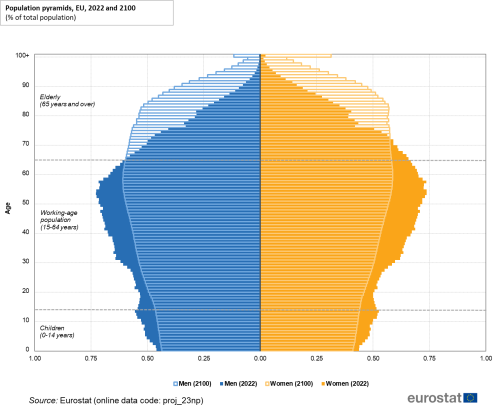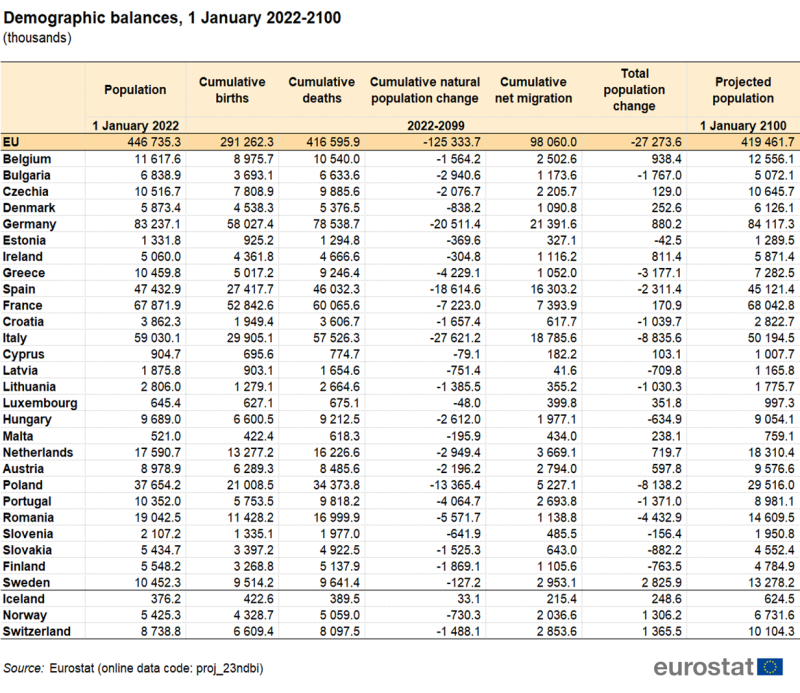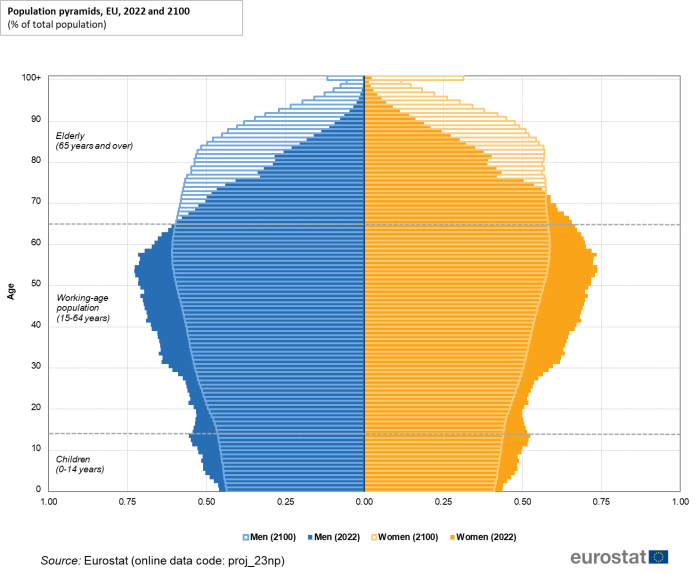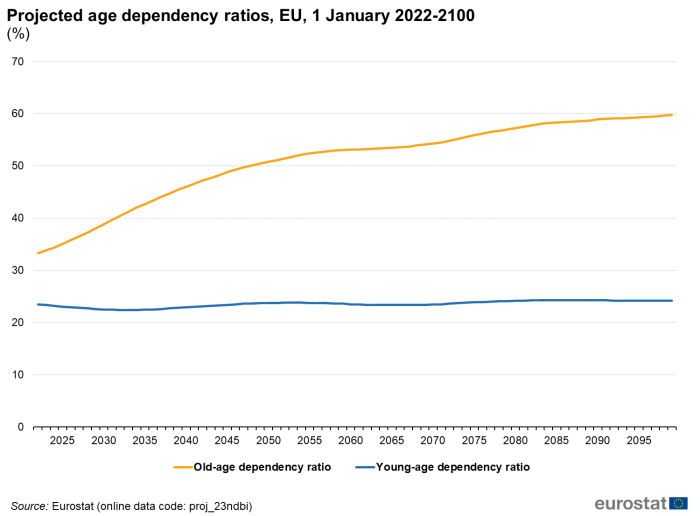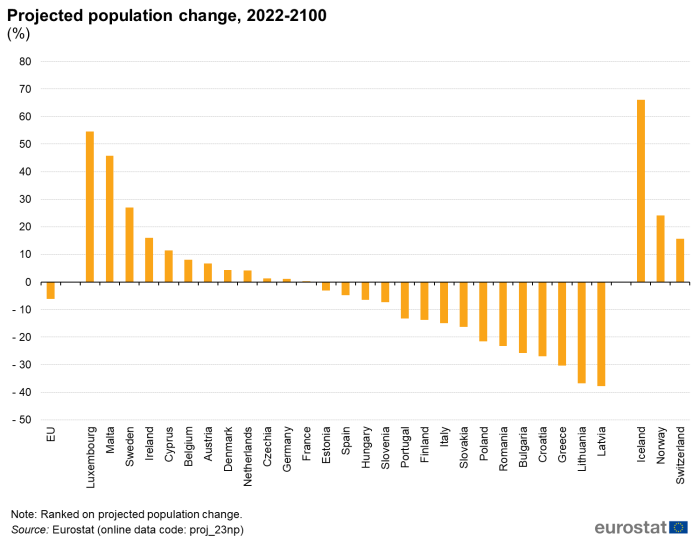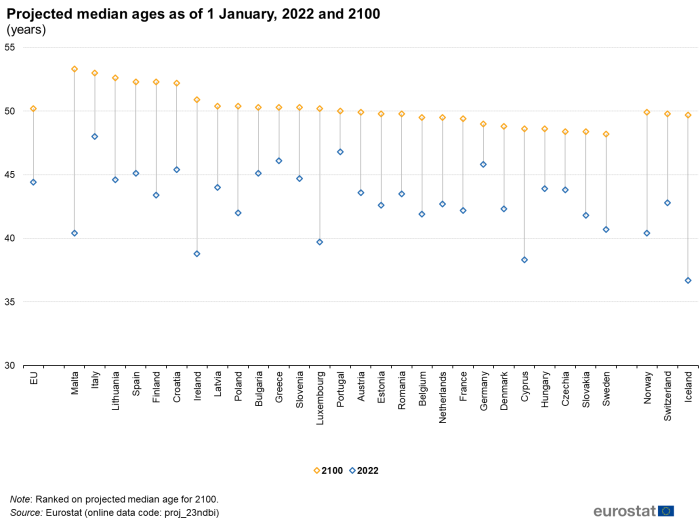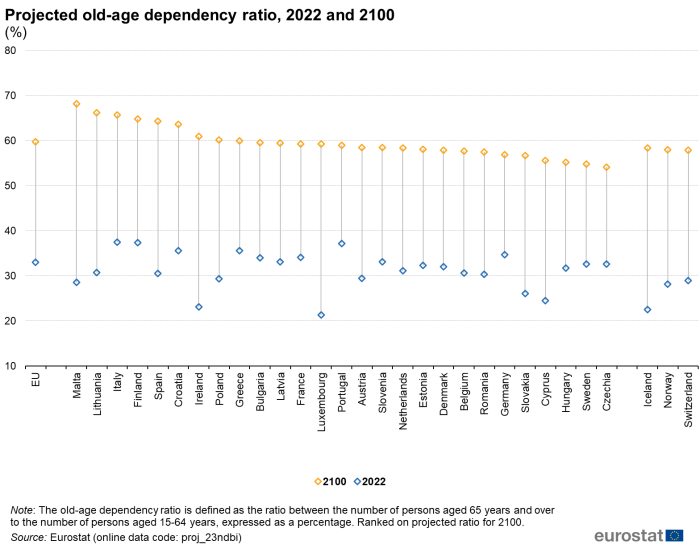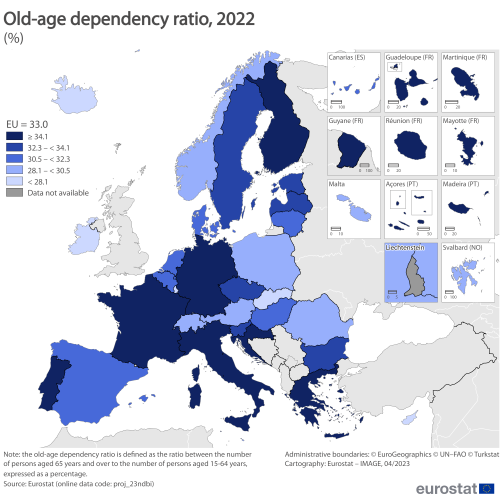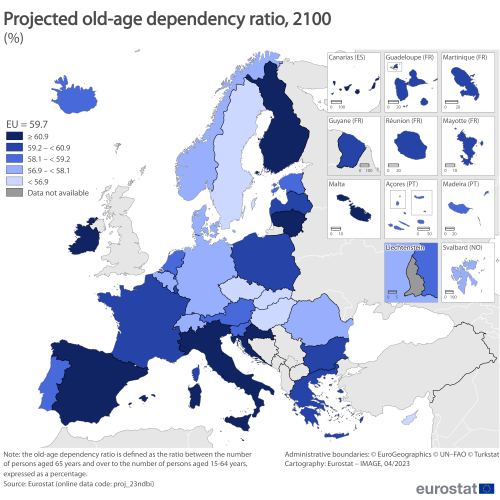Population projections in the EU
Data extracted in March 2023
Planned update date: June 2026
Highlights
The EU population is projected to increase from 446.7 million in 2022 and peak at 453.3 million in 2026 (+1.5 %), then gradually decrease to 447.9 million in 2050 and to 419.5 million in 2100.
Median age of the EU population expected to increase by 5.8 years between 2022 and 2100.
Number of people aged 80 years and over projected to rise to 64.0 million in EU by 2100.
This article focuses on the likely developments of the population size and structure for all European Union (EU) Member States and three of the four European Free Trade Association (EFTA) countries, covering the period 2022 to 2100, based on the latest EUROPOP2023 population projections released by Eurostat on 30 March 2023.
The size of a population changes over time as a function of three demographic events: births, deaths and migratory flows, each of which shapes the population's structure over time. The main outcome of the current levels of fertility and mortality in the EU is a progressive ageing of the population. This is an ongoing demographic process and its consequences are analysed by policymakers from social, economic and labour-related perspectives.
EUROPOP2023 are deterministic projections, or 'what-if' population projections, based on assumptions formulated on a future course of fertility, mortality and migration. The scenario is that of partial convergence among the countries included in EUROPOP2023 in fertility, mortality and migration developments. The methodology applied in EUROPOP2023 builds heavily upon the previous projections exercises and their methodological reports are useful complements to this note. Given past and current developments, this exercise takes in addition the impact of the COVID-19 pandemic into consideration, as well as the impact of the mass influx of displaced persons as a result of the Russian military aggression against Ukraine.
Full article
Population projections
EUROPOP2023, the latest population projections released by Eurostat on 30 March 2023, provide the baseline projections for population developments from 2023 to 2100 for 30 European countries: all of the EU Member States and three EFTA countries (Iceland, Norway and Switzerland), using data for population on 1 January 2022 as a starting point.
Eurostat's population projections result from the application of a set of assumptions on future developments for fertility, mortality and net migration. The projections should not be considered as forecasts, as they show what would happen to the resulting population structure if the set of assumptions are held constant over the entire time horizon under consideration; in other words, the projections are 'what-if' scenarios that track population developments under a set of assumptions. As these projections are made over a relatively long time horizon, statements about the likely future developments of the EU's population should be treated with caution and interpreted as only one of a range of possible demographic developments.
This article presents the main results of the baseline projections and includes the most recent official statistics available at the time of writing this article; for a more detailed presentation of the latest data, please refer to the article on population and population change statistics.
EU population projected to grow slightly in the first 5 years, followed by a steady decline until the end of the century
The EU population is projected to increase from 446.7 million in 2022 and peak to 453.3 million in 2026 (+1.5 %), then gradually decrease to 447.9 million in 2050 and to 419.5 million in 2100, thus with an overall decrease of 27.3 million (-6.1 %) from 2022 to 2100 (see Figure 1).
Across countries, for twelve EU Member States and all three EFTA countries covered here, the projected population size will be higher in 2100 than in 2022, with net migration being the main contributor to the population growth (see Table 1).
Ageing society
The Eurostat baseline scenario projects that the current pattern of population ageing in the EU is likely to continue until 2100, with both the size and the proportion of older persons in the total population increasing. Various demographic indicators are used to analyse the shift in age distribution towards older ages, including:
- the median age;
- the proportion of population in each of the main demographic age groups - children (defined here as those aged 0-14 years), the working-age population (15-64 years) and the elderly population (65 years and over); and,
- age-dependency ratios - such as the young-age dependency ratio, the old-age dependency ratio or total-age dependency ratio.
Median age of the EU population projected to increase by 5.8 years by 2100
The median age of the EU population, which divides the total EU population into a younger and an older half, is projected to increase from 44.4 years in 2022 to 50.2 years in 2100. The increase is projected for both men and women, with the gender gap increasing from 3.1 years in 2022 to 4.0 years by mid-century, to finally fall to 2.5 years in 2100. Median ages are projected to increase by +6.2 years for men (from 42.8 years in 2022 to 49.0 years in 2100) and by +5.6 years for women (from 45.9 years in 2022 to 51.5 years in 2100).
The projected relative and absolute sizes of different age groups follow contrasting developments (see Figure 2). The proportion of children (0-14 years old) in the EU total population is projected to decline in both relative and absolute terms, from a share of 15.0 % (69.9 million) at the beginning of 2022 to 13.2 % (55.2 million) in 2100, with the sharpest decline to occur by 2035. The share of working-age population (15-64 years old) in the EU total population is projected to decrease from 63.9 % (285.5 million) at the beginning of 2022 to 54.4 % (228.1 million) in 2100, representing an overall reduction of 57.4 million persons. The sharpest decline is projected to occur by 2038, reaching 60.0 %, followed by a steady moderate decline until the end of the projection horizon. The proportion of elderly (65 years and over) in the EU total population is projected to increase from 21.1 % (94.3 million) at the beginning of 2022 to 32.5 % (136.1 million) in 2100. As such, the share of elderly persons is projected to rise by +11.4 percentage points (pp), corresponding to additional 41.8 million persons by 2100. With the overall EU population declining by 2100, this is the only main demographic age group that is projected to grow, both in relative and absolute terms, indicating a continuation of population ageing.
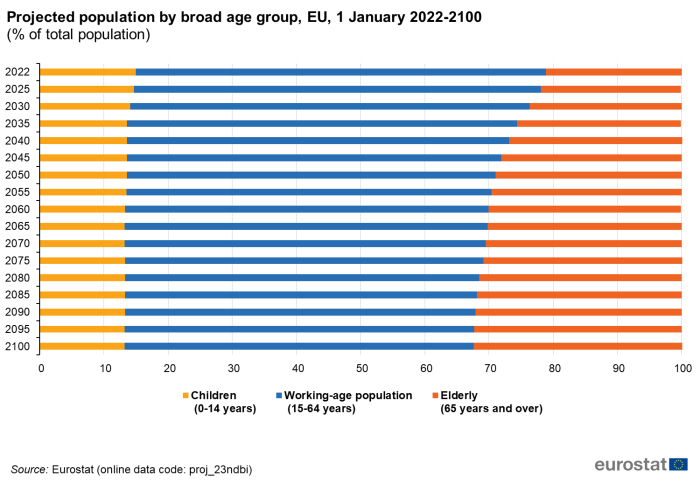
(% of total population)
Source: Eurostat (proj_23np)
People aged 80 years and over projected to rise to 64 million in EU by 2100
The shift in population structure towards older ages is projected to continue in all EU Member States and all three EFTA countries covered here. In the second half of the century, however, the projected dynamics of this phenomenon will be more complex in many countries through the emergence of noticeable fluctuations. The number of very old people (defined here as those aged 80 years and over) in the total EU population is projected to more than double both in absolute and relative terms, from 27.1 million in 2022 (6.1 %) to 64.0 million (15.3 %) in 2100.
Figure 3 provides a graphical presentation of changes in the EU population between 2022 and 2100 by superimposing two population pyramids. Each pyramid shows the distribution of the population by age and sex, where the length of the bars corresponds to the share of a given age group for that sex in the total population. The differences between these pyramids highlight the changes that will occur in the projected population structure of the EU between 2022 and 2100:
- the population of children (0-14 years old) is projected to decrease modestly due to a lower number of births; this narrowing process is known as 'ageing at the bottom' (of the population pyramid);
- the working-age population (15-64 years old) is projected to shrink considerably, increasing its burden of supporting the elderly;
- the elderly population is projected to grow much larger — as shown by the broadening at the top of the pyramid — reflecting the ageing of the EU's population as a result of lower mortality rates;
- in 2100 the number of centenarian women is projected to be almost three times higher than the number of centenarian men.
In 2100, there will be only five people of working age for every three elderly persons
Demographic dependency ratios are based on the age structure of the population rather than their employment status. Figure 4 shows the developments of the two projected age-dependency ratios for the EU, covering the period 2022 to 2100. According to the projections, the young-age dependency ratio will be almost constant throughout the projection period, at an average of 23.6 %. Instead, the old-age dependency ratio is projected to increase rapidly until 2050, reflecting the ongoing retirement of baby-boomers and subsequent age cohorts and then keep growing at a lower rate until the end of the century. Indeed, the old-age dependency ratio is projected to increase by 26.7 pp from 33.0 % in 2022 to 59.7 % in 2100. Therefore, while in 2022 there was exactly one elderly person for every three people of working age, it is projected that in 2100 there will be nearly two elderly persons for the same number of people of working age.
Population projections by country
In 2100, Germany will remain the most populous EU Member State followed by France and Italy as in 2022
Between individual countries, the changes in the projected population structure vary considerably, both in terms of when the highest level of population will be reached and the direction and magnitude of change. According to the projections, in 2100 the most populous EU Member States will be Germany (84.1 million inhabitants), France (68.0 million), Italy (50.2 million), Spain (45.1 million) and Poland (29.5 million), the same ranking as in 2022.
Figure 5 shows the projected population changes between 2022 and 2100. An increase in the number of inhabitants is projected for 12 EU Member States and for all three EFTA countries considered here. Population numbers are projected to rise by more than 25.0 % in four countries: Iceland (with an increase by 66.0 %), Luxembourg (+54.5 %), Malta (+45.7 %) and Sweden (+27.0 %). The rapid population increases in Iceland, Luxembourg and Malta are largely due to the assumption that the relatively high levels of immigration seen in the last decade will be sustainable. Of the remaining countries, growth by more than 10.0 % is projected for Norway, Ireland, Switzerland and Cyprus.
The largest population losses by 2100 are projected in several eastern and southern EU Member States
By contrast, the number of inhabitants is projected to fall between 2022 and 2100 in 15 EU Member States. Among these, there will be a relatively modest decline in the total number of people living in Estonia, Spain, Hungary and Slovenia, where the population is expected to contract by less than 10 %. Larger declines in the population, within the range of 10-20 %, are projected for Portugal, Finland, Italy and Slovakia, while large reductions of 20-30 % are projected for Poland, Romania, Bulgaria, Croatia and Greece. The largest losses — with the total number of inhabitants between 2022 and 2100 falling by more than 30.0 % — are projected for Lithuania (-36.7 %) and Latvia (-37.8 %).
By 2100, the populations of all EU Member States will be ageing, although the rate of change will vary considerably. These differences are reflected in the changes in projected median age and age dependency ratios. This pattern of population ageing is already being experienced in some EU Member States and is projected to continue and, in some cases, develop at an even faster pace, with a growing number of persons becoming dependent on the working-age population. As a result, population ageing will likely have a considerable impact on public expenditure plans, for example, in relation to pensions, healthcare and long-term care costs.
Figure 6 shows that during the period 2022 to 2100, the median age of the EU population is projected to increase by 5.8 years to reach 50.2 years in 2100. All countries are expected to experience an increase in the median ages of their population. Malta, Ireland, Luxembourg and Cyprus, which in 2022 enjoyed the lowest median ages in the EU, are the only EU Member States projected to see their median ages rising by more than 10 years (increases of +12.9 years, +12.1 years, +10.5 years and +10.3 years respectively). The smallest increase +3.2 years is projected for Germany (from 45.8 years in 2022 to 49.0 years in 2100) and Portugal (from 46.8 years in 2022 to 50.0 years in 2100). Sweden is projected to have the youngest population in 2100, with a median age of 48.2 years, followed closely by Czechia and Slovakia (both 48.4 years).
Eurostat projections indicate that by the end of the century, the median age is likely to rise above 52.0 years in six countries: Malta (53.3 years), Italy (53.0 years), Lithuania (52.6 years), Spain (52.3 years), Finland (52.3 years) and Croatia (52.2 years).
Age dependency ratios
Between 2022 and 2035, the share of children (0-14 years old) in the total EU population is projected to decline at a modest rate, from 15.0 % to 13.6 % (-1.4 pp); thereafter, the share will remain stable at 13.6 % until around 2050, after which it will fall further to 13.3 % to remain around this level until the end of the century. Over the period 2022 to 2035, the share of children (0-14 years) in the total population is projected to decrease in all EU Member States except Germany, for which a narrow increase of +0.3 pp is projected (up to 14.2 % in 2035) and Denmark, which is projected to remain at the same level as in 2022. Small contractions of less than 1.0 pp are projected for six EU Member States: Netherlands, Luxembourg, Portugal, Cyprus, Austria and Malta. The largest contraction in 2035 is projected for Ireland (-4.4 pp), a country which had the highest share among EU countries in 2022. After 2036, modest growth is projected in some countries, while for others contractions will continue until 2100, often with mild oscillations.
The EU young-age dependency ratio — which compares the number of children with the number of people in the working-age population (15-64 years old) — is projected to decrease by 1.0 pp during the period 2022 to 2035, from 23.4 % to 22.4 %. Thereafter, the rate will grow very slowly to 24.2 % in 2100, with some very small oscillations.
Among the EU Member States, nine are likely to have an increase in the young-age-dependency ratio by 2100. The highest increase is projected for Portugal (+3.8 pp). Of the remaining countries, increases above 2.0 pp are projected for Germany (+2.8 pp), Hungary (+2.6 pp), Slovakia (+2.5 pp), Austria and Greece (both +2.2 pp). The young-age dependency ratio is projected to decrease in ten EU Member States, with the highest contraction in Ireland (-5.9 pp). By 2100, the EU countries with the highest young-age dependency ratio are expected to be Slovakia (26.6 %) and France (26.2 %), while on the opposite side of the scale will be Italy (21.5 %) and Malta (21.7 %).
The share of the working-age population is projected to decline in all EU Member States between 2022 and 2100
In 2022, the EU's working-age population (15-64 years old) accounted for almost two-thirds (63.9 %) of the total population. This share is projected to decline continuously, down to 56.6 % by 2060, followed by a decade-long plateau and then a further decline to 54.4 % by 2100 (-9.5 pp.) In the period 2022-2100, the share of the working-age population in the total population is projected to shrink in all 30 European countries covered by the Eurostat projections. The highest decrease of the share of the working-age population is projected for Malta and Luxembourg (both -14.7 pp), Spain (-12.3 pp), Lithuania (-12.2 pp) and Slovakia (-12.0 pp), while the lowest decrease is projected for Sweden (-6.7 pp), France and Czechia (both -7.5 pp).
By contrast, the proportion of elderly persons (aged 65 years and over) in the total population is projected to increase in all 30 European countries during the period 2022 to 2100. At EU level, this proportion is projected to increase from 21.1 % to 32.5 % (+11.4 pp), while at country level the range of increase is projected between +8.5 pp in Portugal (from 23.7 % to 32.2 %) and +17.9 pp in Ireland (from 15.0 % to 32.9 %). Eurostat’s population projections indicate that between 2022 and 2100 the share of elderly persons in the total population will increase by at least +10.0 pp in all EU Member States except Portugal, Germany, Czechia and Greece.
The shrinking number of working-age persons and the growing number of elderly persons will determine the development of the old-age dependency ratio. At EU level, the old-age dependency ratio is projected to rise from 33.0 % in 2022 to 59.7 % by 2100 (+26.7 pp). The larger part of this growth will take place at fast pace during the period 2022 to 2060, when it is projected to reach 53.0 % (+20.0 pp), followed by a decade-long plateau and then a slow rise to 59.7 % by 2100. Among the EU Member States, the highest old-age dependency ratio in 2100 is projected for Malta (68.2 %), Lithuania (66.2 %) and Italy (65.7 %), while the lowest are projected for Czechia (54.1 %) and Sweden (54.8 %).
Already in 2050, the projections indicate that there will be less than two people of working-age for every elderly person in the EU
In 13 EU Member States, the old-age dependency ratio is projected to be higher than 50.0 % by 2050 — in other words, there will be less than two working-age persons for each person aged 65 years and over. For three EU Member States — Greece, Portugal and Italy — the old-age dependency ratio is projected to exceed 60.0 % by 2050.
Map 1 and Map 2 illustrate the changes in projected old-age dependency ratios between 2022 and 2100. In 2022, the old-age dependency ratio ranged across the EU Member States from lows of 21.3 % in Luxembourg to highs of 37.5 % in Italy, 37.4 % in Finland and 37.2 % in Portugal. By 2100 the situation is projected to change considerably, with the old-age dependency ranging from 54-55 % in Czechia, Sweden, Hungary and Cyprus, up to highs of 68.2 % in Malta and 66.2 % in Lithuania.
A similar pattern of development is projected for the very old population as a share of the total population. The proportion of the EU population aged 80 years and over stood at 6.1 % in 2022 and is projected to reach 15.3 % by 2100 (+9.2 pp). Eurostat's projections indicate that for all 30 European countries the share of the total population aged 80 years and over will be higher than 13.0 % by 2100. Among the EU Member States, this share will range from 13.3 % in Cyprus to 17.4 % in Italy. There are 18 EU Member States for which the projections indicate that the share of the very old in the total population will increase between 2022 and 2100 by more than the EU average (9.2 pp), with the largest gains expected in Ireland (+12.8 pp) and Malta (+12.5 pp); by contrast, the smallest increase is projected for Germany (+6.6 pp).
The combined effect of a slightly declining number of children, a shrinking of the working age population and a continuously rising number of older persons is that of a considerable increase in the total-age dependency ratio. Among the EU European countries, 23 had more than 50 dependants for every 100 working-age persons in 2022. By 2100, it is projected that all EU countries will have more than 77 dependants per 100 working-age persons.
Impact of births, deaths and migration on population change
At EU level, over the entire period between 2022 and 2100, a higher number of deaths than live births is projected, resulting in a continuous negative natural change (the difference between births and deaths) with different patterns of evolving. Figure 8 shows the likely developments for each vital event, with the widest gap between the numbers of deaths and births projected for the decade from 2055 to 2064, exceeding 2.0 million persons.
At country level, Eurostat's projections indicate that there will be considerable differences in natural population changes developments during the period from 2022 to 2100, with:
- Mixture of positive and negative natural population changes over the projections' horizon — for 8 EU Member States (Sweden, Luxembourg, Ireland, Cyprus, France, Malta, Netherlands, Denmark) and the three EFTA countries;
- Negative natural change in each year of the projections' horizon — for the remaining EU Member States.

(million)
Source: Eurostat (proj_23ndbi)
Migratory patterns — immigration and emigration — also have an impact on population age structures, resulting from either positive net migration (more people arriving in a country than leaving it) or negative net migration (more people leaving a country than arriving). In those EU Member States which are characterised by positive net migration, it is possible that the process of population ageing may be slowed down, as migrant populations often have a high share of working-age persons. On the other hand, with negative net migration, the ageing process may be accelerated, as those leaving the country may also be relatively young, thereby reducing the number of working-age persons in the population, while also reducing the fertility rate.
Figure 9 shows the contributions of natural population change and net migration to the total population change in the EU during the period 2022 to 2100, suggesting that for the entire projections horizon:
- Net migration will be positive over the entire period and will be the only component contributing to the population growth; it is projected to be almost constant, on average 1.2 million, over the entire projection horizon; and
- Natural change (defined as the difference between the numbers of live births and deaths) will be negative over the entire period, hence contributing negatively to the population growth; its decrease will continue until 2060, followed by a modest increase by 2100.
Over the period 2022 to 2100, Eurostat's projections suggest there will be 291.3 million births and 416.6 million deaths in the EU, equivalent to a net reduction of 125.3 million people due to natural changes in the population. The cumulated net migration is projected to contribute an increase of 98.1 million persons, resulting in an overall decrease of 27.3 million people in the total EU population.

(million)
Source: Eurostat (proj_23ndbi)
Alternative scenarios
The population projections produced by Eurostat are deterministic projections, and a specific set of assumptions for fertility, mortality and migration fully determines the projected population. In addition to the baseline assumptions, Eurostat also formulates five alternative scenarios to give insights into the impact change in the assumptions have on the projected population. For the EUROPOP2023 round, these scenarios are lower fertility, lower mortality, as well as zero net migration, lower non-EU immigration and higher non-EU immigration. Specifically, for the scenario on lower fertility, the assumption is that the total fertility rate is 20% lower than that of the baseline in each year covering the projection horizon (2023 - 2100). This means that each year, the number of live births is lower than in the baseline scenario. The scenario on lower mortality is implemented such that in 2100, the life expectancy at birth is two years higher than in the baseline scenario. The scenarios on migration cover zero net migration, as well as 33% less immigration from non-EU countries in each individual year and 33% more immigration from non-EU countries in each year covering the projection horizon.
Figure 10 shows that these different scenarios lead to differences in projected population. For the EU, the scenario of higher migration is the only one that results in an increase in population in 2100 in comparison with 2022. The impact of the different scenarios in each country depends on the individual demographic situation; countries that experience periods of negative net migration will for example show increases in the projected population for some periods in the zero net migration scenario, while those with positive net migration will show decreases in the projected population for that scenario.
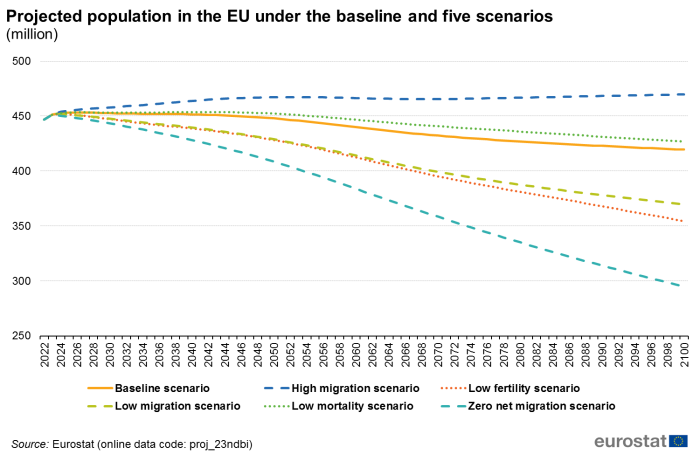
(million)
Source: Eurostat (proj_23ndbi)
Demographic future — a greying population
Eurostat's population projections indicate that population ageing will continue across all of the EU Member States and the three EFTA countries covered here. The EU population is projected to be lower in 2100 than it was in 2022 and its structure will be increasingly old, with a considerable reduction in the number and share of working-age persons. The ageing process may be highlighted through the increasing number of very old persons, whereby the elderly population is itself in the process of ageing. While migration has the potential to help delay the ageing process in some of the EU Member States, it may also speed up the process of ageing in those Member States which are characterised by a relatively high proportion of their working-age population leaving, for example in search of more attractive jobs. Indeed, the latest projections indicate that age dependency ratios are likely to continue to increase, highlighting challenges for public expenditure in relation to pensions, healthcare and long-term care costs.
Source data for tables and graphs
Context
Europeans are living longer and healthier lives than ever before. Along with an increase in longevity, Europe is witnessing an overall ageing population, which brings with it both opportunities and challenges. Information on the work of the European Commission 2019-2024 to tackle the impact of demographic change in Europe can be found in the European Commission dedicated pages. Most recently, on 17 January 2023, the European Commission published a Staff Working Document on The impact of demographic change in a changing environment which provides further analysis of the demographic consequences of the COVID-19 pandemic.
Direct access to
